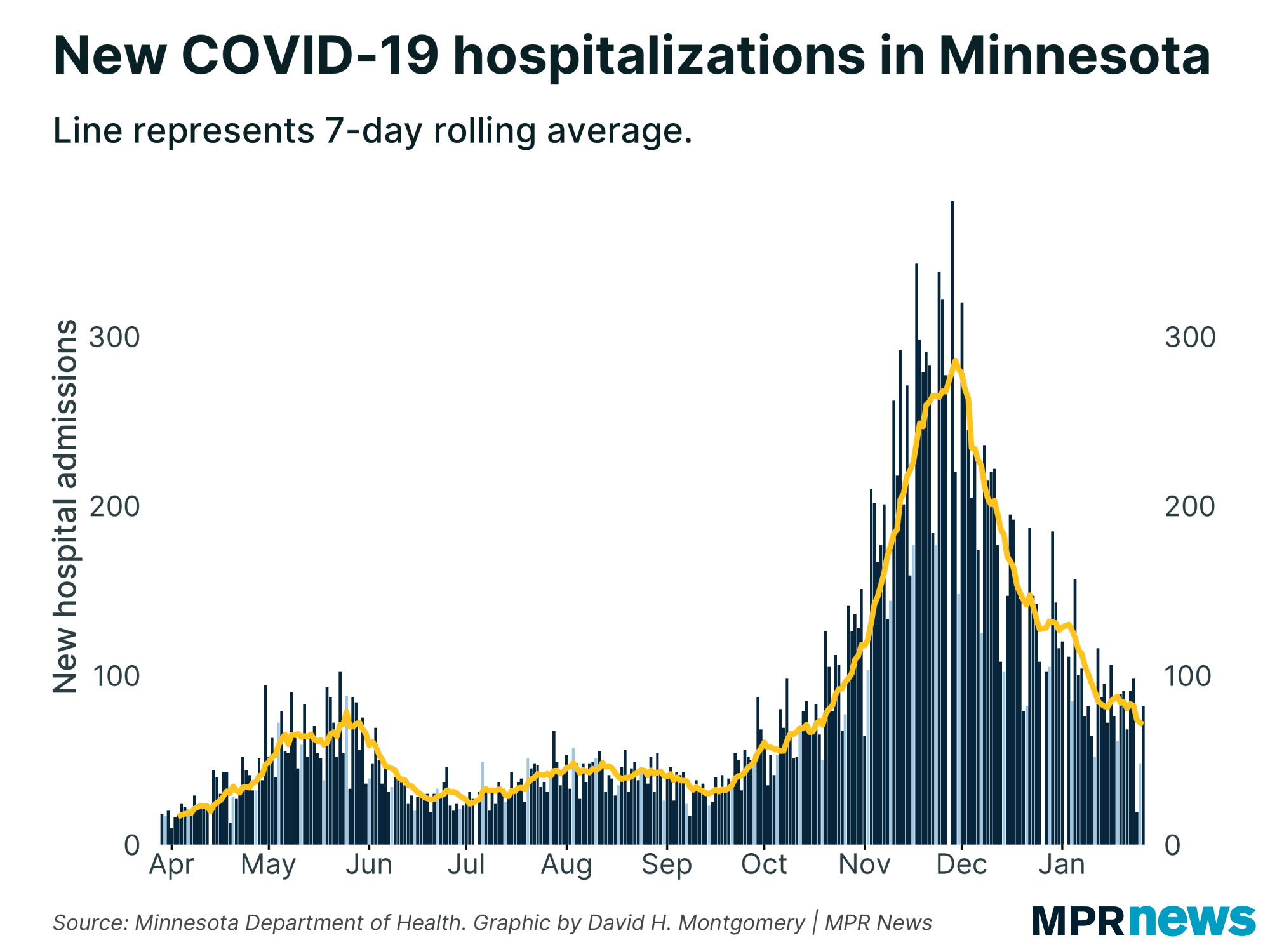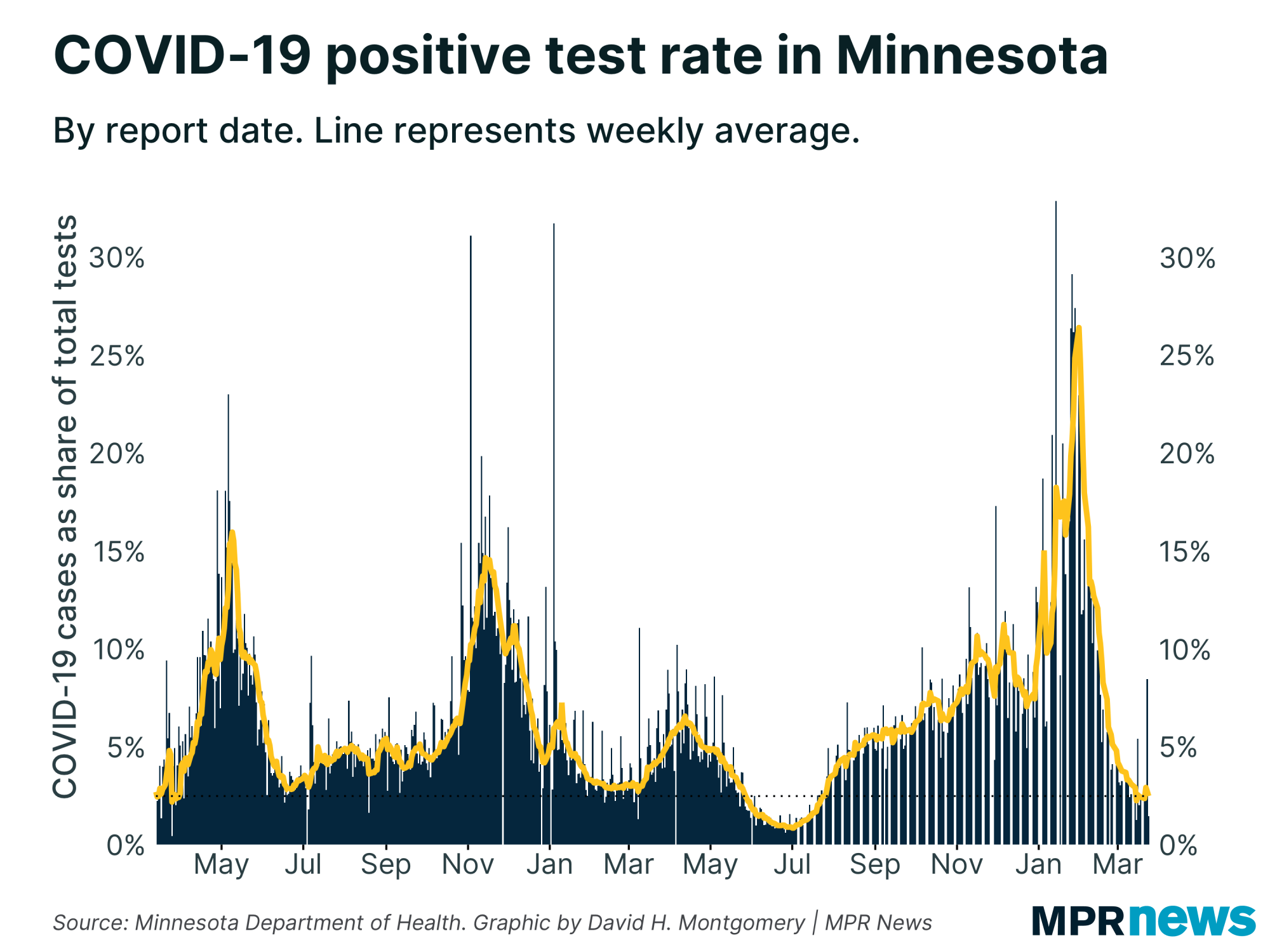Nov. 9 update on COVID-19 in MN: 4K more cases, 19 more deaths

Go Deeper.
Create an account or log in to save stories.
Like this?
Thanks for liking this story! We have added it to a list of your favorite stories.
Updated: 1:25 p.m.
Minnesota reported nearly 4,000 newly confirmed or probable cases of COVID-19 on Monday. That’s down from Sunday’s record, but it still wasn’t good news.
A drop in testing volume explained the relatively lower new caseload. However, the positive test rate, a key measure of whether the disease is spreading, continued to climb.

Nineteen more people were reported to have died from the disease. Death counts are rising inside and outside long-term care facilities. More deaths were recorded in the last seven days than in any week during the pandemic.
About 1,000 people are in Minnesota hospital beds now from COVID-19, including more than 200 needing intensive care. New hospital admissions continue to rise to new records, with the current seven-day average running at 176 per day.
Turn Up Your Support
MPR News helps you turn down the noise and build shared understanding. Turn up your support for this public resource and keep trusted journalism accessible to all.

The newest numbers come after a week of record case increases — more than 31,000 new cases reported since last Monday — as hospitalizations and deaths climbed steeply. A tough October became a brutal first week of November.
Uncontrolled spread is being fueled by Minnesotans’ informal gatherings and get-togethers with family and friends where it’s spread unknowingly by people who have the virus but do not have symptoms, officials say.
“Our behavior is driving this … literally thousands and thousands of small decisions happening around Minnesota that are the issue here,” Minnesota Health Commissioner Jan Malcolm said Friday.
Of the 184,788 confirmed or probable cases identified in the pandemic to date, about 81 percent have recovered to the point they no longer need to be isolated.
Gov. Tim Walz said Monday that he plans to announce new restrictions that target active spreaders of COVID-19 in an effort to bring the coronavirus under control as cases have surged to dangerous levels in recent weeks.
Walz plans to unveil at least some of his restrictions on Tuesday, hinting that they would be more “surgically, much more aggressively” targeted than the 51-day stay-at-home order from the spring.

The deaths reported Monday raised Minnesota’s toll to 2,675. Among those who’ve died, about 69 percent had been living in long-term care or assisted living facilities; most had underlying health problems.

Caseloads rising across age groups
New cases are up dramatically over the past six weeks in all age groups.
People in their 20s still make up the age bracket with the state’s largest number of confirmed cases — nearly 40,000 since the pandemic began, including nearly 22,000 among people ages 20-24.

The number of high school-age children confirmed with the disease has also grown, with more than 15,600 total cases among children ages 15 to 19 since the pandemic began.
Those numbers help explain why experts remain particularly concerned about teens and young adults as spreaders of the virus.
While less likely to feel the worst effects of the disease and end up hospitalized, experts worry youth and young adults will spread it to grandparents and other vulnerable populations. It’s especially concerning because people can have the coronavirus and spread COVID-19 when they don’t have symptoms.
Virus surges in swaths of rural Minnesota
Regionally, central and northern Minnesota have driven much of the recent increase in new cases while Hennepin and Ramsey counties show some of the slowest case growth in the state.
Collectively, rural areas of Minnesota continue to report the most new COVID-19 cases. Northwestern Minnesota no longer has the state’s fastest-growing outbreak. It’s been passed by east-central Minnesota. But new cases are rising at accelerating rates everywhere.

Northern Minnesota, once the region least affected by the disease, has also seen its caseload grow dramatically in recent weeks.

Latino cases jump
In Minnesota and across the country, COVID-19 has hit communities of color disproportionately hard in both cases and deaths.
That’s especially true for Minnesotans of Hispanic descent. They, along with Black Minnesotans are also being hospitalized and moved to intensive care units at higher rates than the overall population.

Similar trends hold true for Minnesota’s Indigenous residents. Counts among Indigenous people jumped in October relative to population.
October data also show newly confirmed cases accelerating among Latino people in Minnesota.
Distrust of the government, together with deeply rooted health and economic disparities, have hampered efforts to boost testing among communities of color, particularly for unauthorized immigrants who fear their personal information may be used to deport them.
‘Minnesota is in a bad spot’
The overall numbers continue to paint a troubling picture of a rapidly worsening pandemic in Minnesota. The latest numbers continue to show rampant spread across Minnesota, not limited to just one region or demographic group. like earlier in the pandemic.

There’s increasing concern about the ability of hospitals to handle more. They were already filling in the summer and fall from normal use, and the surge in COVID-19 patients is putting hospitals in the Twin Cities “near the top of their capacity,” Malcolm said last week.
Staffing is becoming a challenge as more health care workers get sick, she added.
“Minnesota is in a bad spot … and it’s going to get worse before it gets better,” Ehresmann told reporters.
While more testing is uncovering more cases, “it’s not the testing that’s the problem,” Ehresmann said. “It’s the sheer fact that we have so much virus circulating in our state.”
The Associated Press contributed to this report.
Developments around the state
MN opening more sites for free COVID testing
Minnesota is adding more than a dozen new COVID-19 testing locations over the next couple of weeks, including 10 in armories around the state and several locations at Minneapolis-St. Paul International Airport.
On Monday, the state opened a saliva testing site at the Minneapolis Convention Center. Similar testing is already available free of charge at sites in St. Paul, Mankato, Winona, Brooklyn Park, Moorhead, Duluth and St. Cloud.
Health Commissioner Jan Malcolm said the saliva test is as effective as ones that use nasal swabs.
"There's more than one type of saliva test. This one was I believe the first that got FDA emergency use authorization and the reliability is very high,” Malcolm said.
Testing is free and available to anyone who wants to be tested whether they have symptoms or not. The state does not require identification or insurance for saliva testing, but does recommend that patients make an appointment. The tests taken at the Minneapolis Convention Center will be analyzed at a lab in the state and results should be available in 24 to 48 hours, state health officials say.
Other types of testing are available at medical clinics, pop-up sites and temporary locations throughout the state.
Health authorities recommend testing for anyone who is exhibiting symptoms, or people who have been exposed, think they've been exposed or think they need to be tested.
More details are available on the Minnesota Department of Health website.
— MPR News Staff
Record sixth special session set for Thursday
Minnesota lawmakers are coming back into special session on Thursday to decide if Gov. Tim Walz will maintain his emergency powers to manage the coronavirus response.
Walz called the special session in a proclamation Monday because he is again extending the executive order tied to COVID-19 measures his administration has taken. That will remain in place for an additional 30 days unless both the House and Senate vote to unwind the authority. That’s unlikely given that the Legislature is under split-party control.
Walz said the climbing cases require a nimble response.
“This is a dangerous phase of this pandemic. We’re in the midst of a surge in case positivity and hospitalizations,” he said in a written statement. “Extending the peacetime emergency will help ensure we have the tools we need to respond quickly to protect Minnesotans’ health and well-being.”
House Speaker Melissa Hortman, DFL-Brooklyn Park, said she’s expecting a quick special session.
“A real ‘Groundhog Day’ event — so very similar to what we saw in August and September when we were in the quiet period and talked about the emergency powers and did not pass legislation,” she said. “I anticipate that’s what kind of special session it will be.”
The Minnesota Legislature has had an unprecedented five special sessions already this year due to the pandemic. Last week’s election won’t alter party control next year, but Democrats will have a narrower edge in the House and Republicans will lead the Senate by a single seat.
— Brian Bakst | MPR News
Walz order gives teachers more distance learning prep time
A new executive order from Gov. Tim Walz gives teachers more time to prepare for teaching in distance and hybrid learning scenarios.
The new order mandates that districts build in more time to each school day for K-12 teachers to plan their lessons. Now schools must set aside 30 minutes of preparation each day in places where educators are teaching full-time distance learning or a combination of distance and in-person instruction.
The order comes after many teachers raised concerns about not having enough time to prepare for a drastically different learning model as schools have adapted to the COVID-19 pandemic. The changes may mean schools will have to adjust their schedules. Districts have until Nov. 30 to implement the new order.
— Elizabeth Shockman | MPR News
Top headlines
Pfizer says COVID-19 vaccine is looking 90 percent effective: Pfizer says an early peek at its vaccine data suggests the shots may be 90 percent effective at preventing COVID-19, indicating the company is on track later this month to file an emergency use application with U.S. regulators.
Minnesota's elder care facilities try to balance safety with mental health as COVID rises: As winter nears, long-term care facilities across the state are figuring out how to safely bring more visitors inside, while keeping the growing pandemic threat outside. In doing so, the home operators are hoping to boost the mental health of residents.
CentraCare hospitals feeling strain of COVID-19 surge in central Minn.: Almost a quarter of the patients at St. Cloud Hospital have COVID-19, and the intensive care units at CentraCare hospitals are nearly full, with more than half of those cases related to the virus.
COVID-19 in Minnesota
Data in these graphs are based on the Minnesota Department of Health's cumulative totals released at 11 a.m. daily. You can find more detailed statistics on COVID-19 at the Health Department website.



